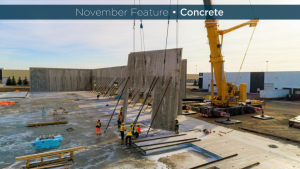TORONTO — A region in northern Ontario was chosen Thursday as the site to hold Canada’s nuclear waste in a deep geological repository, a critical milestone in a $26-billion, decades-long project to bury millions of used fuel bundles underground.
The Nuclear Waste Management Organization, a non-profit body funded by the corporations that generate nuclear power and waste, announced that Ignace in northwestern Ontario will be the site, after both the town’s council and Wabigoon Lake Ojibway Nation were willing to move forward.
Laurie Swami, president and CEO of the NWMO, said the organization will now start the regulatory process, which could take seven to 10 years. Construction is expected to take 10 years, with operations set to begin in the 2040s.
“I’m really excited that we’ve been able to select the site, that we have willing and informed communities that are willing to move forward with us into the next step of this,” she said.
“We believe this is a very good place to locate our deep geologic repository, and in the next phase, we’ll be going through the regulatory process, which will confirm our position on the safety of this site.”
The site selection process began in 2010 with 22 potential locations and was eventually narrowed down to two finalists in Ontario. Both Ignace and Wabigoon Lake Ojibway Nation in northern Ontario decided to move ahead, while the “yes” side narrowly won in a referendum in the Municipality of South Bruce.
But nearby Saugeen Ojibway Nation had not made a decision, and the NWMO had a timeline of selecting a site by the end of this year.
“We’ve been working with Saugeen Ojibway Nation for many years, and despite our best efforts, we did not see a path forward where Saugeen would be in a position to determine their willingness in the short, probably the mid-term,” Swami said.
Chief Clayton Wetelainen of Wabigoon Lake Ojibway Nation said his community’s role as the potential host for Canada’s used nuclear fuel is one of the most important responsibilities of our time.
“We can not ignore this challenge and allow it to become a burden for future generations,” he wrote in a statement.
The First Nation will ensure that its role as guardians of the land and water remains central to the decision-making process, Wetelainen and the council said, and the project can only continue if it can be proven to be built safely, with respect to the environment and in a way that protects Anishinaabe values.
But Grassy Narrows First Nation, also in northwestern Ontario, is upset with the decision. Grassy Narrows is grappling with generations of mercury poisoning after a mill in Dryden dumped 9,000 kilograms of the substance into the English-Wabigoon River system in the 1960s.
“This decision puts the people of Grassy Narrows in grave danger,” Joseph Fobister, Grassy Narrows’ land protection team lead, said in a statement.
“The transport of extremely dangerous nuclear waste and its disposal within our watershed will do irreparable destruction to our lands, rivers, and our way of life, which have already been damaged by so many harmful decisions imposed on us.”
Ignace Mayor Kim Baigrie said the town was the first to put its hand up to be considered as the host more than 14 years ago.
“Through a constructive process, with integrity, accountability and transparency as our guiding principles, this township learned, educated ourselves and became an integral component of today’s decision by the Nuclear Waste Management Organization,” she wrote in a statement.
Ontario Energy Minister Stephen Lecce said in a statement that he thanks both Ignace and Wabigoon Lake Ojibway Nation for their willingness to host the important project.
“As our government expands our zero-emissions nuclear fleet to meet rising energy demand, Ontario is cementing its position as a world leader in all parts of the nuclear life cycle – this achievement by NWMO is just the latest example,” he said.
Ontario is planning to bolster its output from its already large nuclear fleet, extending the life of the Pickering nuclear plant by two years while considering a larger refurbishment to get decades more out of it, considering building a new large-scale nuclear plant on the site of Bruce Power’s current generating station, and building four small modular reactors.
Lecce also announced Wednesday that he is looking at three new sites in the province for electricity generation facilities, including the possibility of large-scale nuclear plants.
Swami said the planning for the repository will factor in the changing nuclear landscape.
“The used fuel from any new nuclear plants will be many decades into the future, and so there’s lots of time for us to put our adaptations in place,” she said.
The current fleet of reactors in Canada will produce about 5.5 million used fuel bundles, with around 3.2 million already in either wet or dry storage on site at nuclear plants.
After the spent fuel rods come out of a reactor, they spend about 10 years cooling in pools of water before being stored in containers with thick concrete walls lined on the outside with a steel plate. But those containers are only designed to last 50 years, so they are not seen as a long-term solution, the NWMO says.
In a network of rooms connected by cavernous tunnels, as deep below the Earth’s surface as the CN Tower is tall, the nuclear waste is set to be contained in a multi-barrier system.
The used fuel pellets will be inside fuel bundles, or rods, made of corrosion-resistant zircaloy. Those bundles will be inside containers made of carbon steel and coated with copper to prevent corrosion. The containers will be packed within bentonite clay that acts as a barrier to radioactive materials inside.
But environmental groups are concerned about the project, in part because there are no deep geological repositories to store nuclear waste around the world yet in operation.
Brennain Lloyd, with We the Nuclear Free North, said there are several issues with the NWMO’s process in determining sites, host communities and willingness, and called the whole project experimental.
“The NWMO says – and they used it again in their release today – you can’t put off to future generations … dealing with the waste, but it is in fact exactly what they’re doing,” Lloyd said.
“They, right now, could be moving to improve the storage systems, the security of the waste at the reactor stations. They could start doing that now. Instead, they’re punting that off 40 years. And that’s irrational.”
©2024 The Canadian Press











Recent Comments
comments for this post are closed